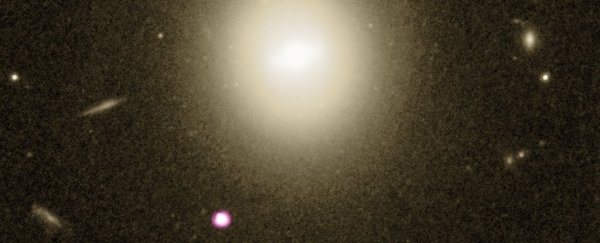The mess created by an encounter between a black hole and an unlucky star has yielded a rare and incredible treasure.
By measuring the X-radiation as the star was torn apart by gravity, astronomers have determined that the black hole is an incredibly elusive beast: an intermediate-mass middleweight black hole, sitting between the stellar-mass lightweights and the supermassive heavyweights.
Scientists think intermediate mass black holes (IMBHs) could be incredibly common, but for some reason, they have proven adept at evading detection, so this discovery is a real prize - one that represents not just a unique laboratory for astroparticle physics, but that could help us unravel the mystery of how supermassive black holes get to their tremendous size.
"The fact that we were able to catch this black hole while it was devouring a star offers a remarkable opportunity to observe what otherwise would be invisible," said astronomer Ann Zabludoff of the University of Arizona.
"Not only that, by analyzing the flare we were able to better understand this elusive category of black holes, which may well account for the majority of black holes in the centers of galaxies."
While the boundaries between IMBHs and supermassive black holes (SMBHs) are currently not very well defined, intermediate-mass black holes are generally considered to be larger than a typical collapsed star or stellar black hole (up to a hundred solar masses) but not supermassive (between a million and a billion times more mass than a typical stellar black hole).
The dearth of detections in the IMBH mass range to date is glaring. So far, astronomers have managed to winkle out a handful of observations that suggest IMBHs, but modeling suggests there should be far more out there.
Black holes, usually invisible, reveal themselves when something like a star gets a little too close. Then, the immense tidal force of the black hole - the product of its gravitational field - first stretches and then pulls the star so hard that it's torn apart.
This tidal disruption event (TDE) releases a brilliant flare of light before the debris of the disintegrated star gradually disappears beyond the black hole's event horizon.
An event of this kind, named 3XMM J215022.4−055108 (J2150 for short), was observed in 2003, in the center of a star cluster on the outskirts of a galaxy 740 million light-years away. Over the course of 10 years, the bright flare faded, providing a wealth of data from the event. Analysis of the photons suggested an IMBH.
Led by astronomer Sixiang Wen of the University of Arizona, the new team has reanalyzed the data, comparing it to sophisticated theoretical models, to more precisely measure the mass and spin of the black hole. They found that the culprit clocks in at around 10,000 solar masses.
And, fascinatingly, it's spinning very fast. The researchers were able to use this fast spin to probe the nature of dark matter. We don't know what dark matter is, but we do know that if it was made up of hypothetical particles called ultralight bosons, the black hole wouldn't be able to spin as fast as observed.
The black hole's fast spin also offers some clues as to how it grew.
"It's possible that the black hole formed that way and hasn't changed much since, or that two intermediate-mass black holes merged recently to form this one," Zabludoff said.
"We do know that the spin we measured excludes scenarios where the black hole grows over a long time from steadily eating gas or from many quick gas snacks that arrive from random directions."
We know that mergers can produce black holes in the intermediate mass range; one such was detected in 2019, producing a black hole 142 times the mass of the Sun. What we don't know is how often this happens, and whether it's the only way black holes can reach this size. We'll need to locate more in order to figure it out.
One place that we might find them is in the centers of dwarf galaxies. We know that the centers of almost all galaxies of the Milky Way's mass or larger host supermassive black holes, and that the mass of the black hole is proportional to the mass of the spherical distribution of stars concentrated in the middle of the galaxy, known as its bulge.
It stands to reason that smaller galaxies should, therefore, have smaller black holes, but actually observing them has proven challenging. But, if most dwarf galaxies are orbiting an IMBH, then we could be able to detect them from their tidal disruption event flares. First, we'll need to increase the detection rate, but upcoming instruments should improve that dramatically.
"By fitting the X-ray emission from these flares to theoretical models, we can conduct a census of the intermediate-mass black hole population in the universe," Wen said.
The research has been published in The Astrophysical Journal.
